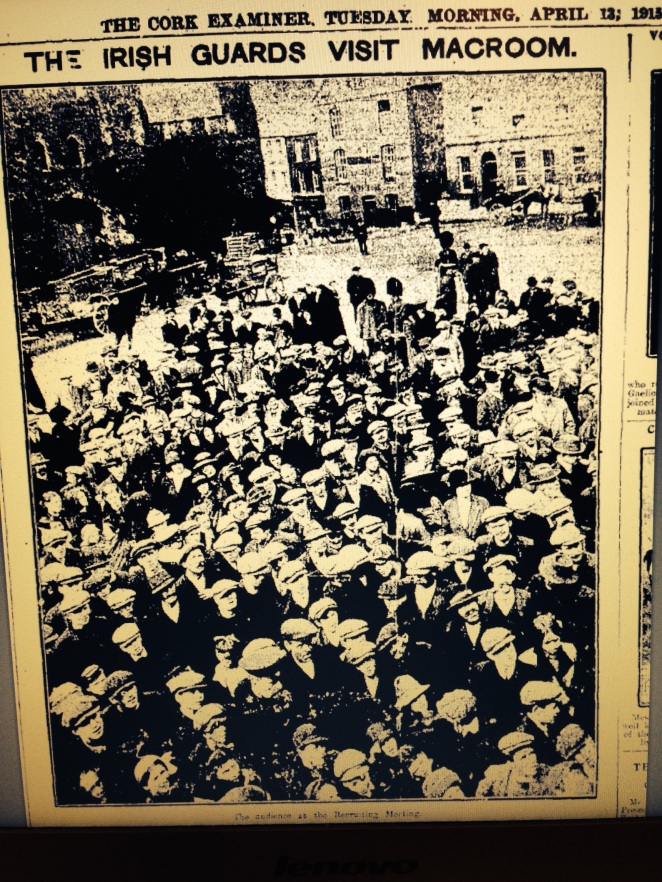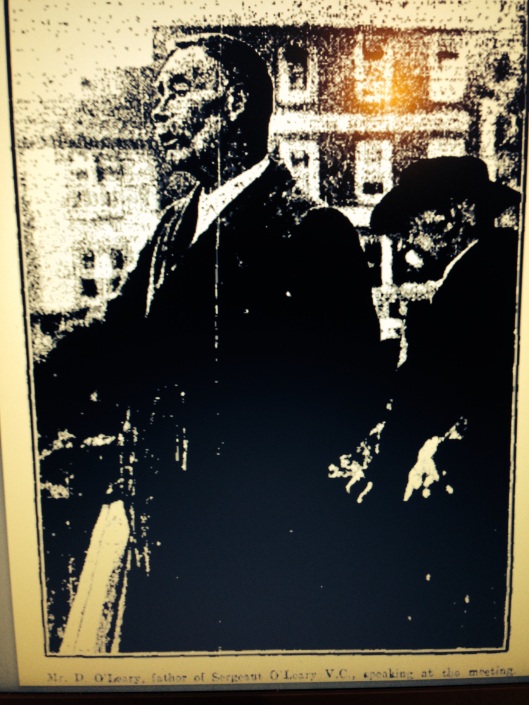It appears like a Royal Irish Constabulary (RIC) uniform is being worn in the crowd at this recruiting meeting in Macroom in mid-April 1915, where the Irish Guards band arrived by train to play in honour of their fellow regiment member, Sergeant Michael O’Leary.
From nearby Inchigeela, he was the first Irishman to be awarded the Victoria Cross medal, and was the talk of Europe for his brave deed when killing 10 Germans and capturing several others on the brickfields of Cuinchy at La Bassée Canal in France on February 1, 1915.
In the same month as this Macroom meeting, and despite the local and international press coverage of O’Leary’s deed, the RIC County Inspector for Cork West Riding reported only about a dozen army recruits were obtained. It didn’t help that the increase of land under tillage, due to the demands associated with the war, meant farmers’ sons were less likely than ever to enlist.
At the same meeting as photographed, the father of Sergeant O’Leary (in July, he was made Lieutenant of the Connaught Rangers), Daniel O’Leary addressed the crowd: ‘The Irish never got their rights from England, but the Irish fought her battles, and some there were who got medals with their hands in their pockets.’ [the Cork Examiner reporter appears to paraphrase O’Leary, rather than these being direct quotes.].
His services as a speaker at such events, designed primarily to drum up support for the war effort and for enlistment, were – perhaps unsurprisingly – soon dispensed with.
A recruiting committee was established in Macroom, whose south square can be seen in the background of the main photo above, in December 1915 to try and rectify the slump in numbers signing up to the British Army.
But the young men of the district, driven largely by fears of looming conscription (if police reports of the time are to be believed), had signed up in their dozens instead in the intervening months to the rapidly-expanding Irish Volunteers.
On a rain-sodden Easter Sunday, April 23, 1916, the same square in Macroom would see around 400 Irish Volunteers parade. They were, very soon after, dismissed (on orders of Irish Volunteers Cork Brigade commanders Tomás MacCurtain & Terence MacSwiney) to return to their home areas – villages around the district, Cork city, as far south as Ballinadee near Kinsale, and as far east as Queenstown (Cobh).
The reasons they were there, who they were, and how they got there – most having marched through Béal na Bláth and Kilmurry en route – will be the subject of a talk I will be giving at Independence Museum Kilmurry as the centenary of that date approaches.
The March to Macroom – a talk by Niall Murray: Tuesday, March 8, 2016, 8pm at Independence Museum, Kilmurry. (Turn off the main Cork-Killarney road on the Macroom side of Lissarda.)
____________________
*** Thanks to Jean Prendergast for bringing the Cork Examiner report of the Macroom visit of the Irish Guards, and of the Southern Star article on the Macroom recruiting committee’s establishment, to my attention.
Please follow her on Twitter (@Cork1914to1924) for a daily diet of how the Munster Fusiliers and other Irish regiments were faring across Europe century ago.
______________________
Some sources:
Cork Examiner, April 13, 1915 (via Irish Newspaper Archive – http://www.irishexaminer.com/archive/ )
Southern Star, December 25, 1915 (the Southern Star archive is available through the same resource as above)
RIC West Cork Riding County Inspector, monthly report, April 1915 (Colonial Office (CO) 904/96/640)
Cónal Creedon, The Immortal Deed of Michael O’Leary (Cork City Libraries, 2015)



Great stuff Niall! We are all looking forward with great interest to you talk in Independence Museum Kilmurry, this will be well flagged in advance
LikeLiked by 1 person